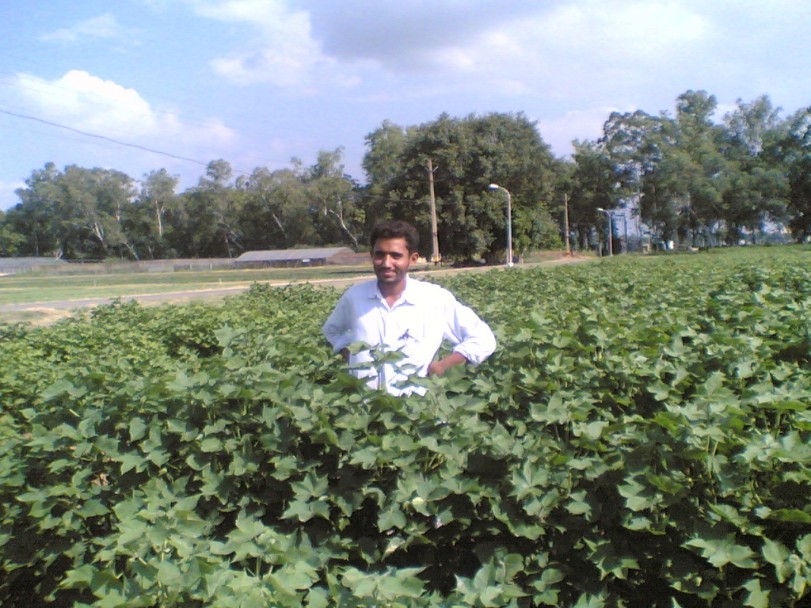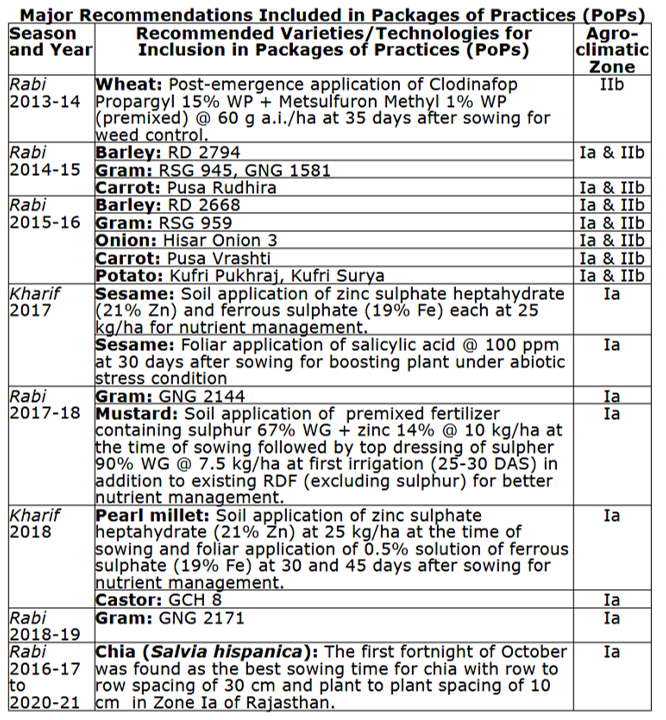A brief of research work carried during post graduations and thereafter
A. During Master’s Degree at Department of Agronomy, Marathwada Agricultural University, Parbhani (Maharashtra)
Title: Response of newly released cotton (Gossypium hirsutum L.) varieties to plant densities and fertilizer levels
The exploitation of new genotypes (G. hirsutum) has opened up new horizons in cotton production. Cotton breeders of MAU, Parbhani have released genotypes viz. NH 545 and PH 348 (Yamuna). The yield parameters and their components have been found to vary with plant populations and the applied fertilizers. Therefore, the potentiality of such genotypes can fully be realized only after determining their nutrient needs and plant geometry.
The field investigation entitled “Response of newly released cotton varieties to plant densities and fertilizer levels” was conducted on clayey soils of Cotton Research Scheme, Marathwada Agricultural University, Parbhani (Maharashtra) during kharif season of 2004 to find out the suitable plant density and fertilizer level for higher productivity and quality of newly released cotton varieties viz. NH 545 and PH 348. The soil of experimental field was well drained, clayey in texture, low in available nitrogen, medium in available phosphorus and high in available potash and slightly alkaline in reaction. The experiment was laid out in a split plot design with three replications. Main plot treatments comprised of nine combination of three plant densities i.e. D1-55555 plant/ha (60X60 cm2), D2 – 37037 plants/ha (60 x 45 cm2), D3-27777 plants/ha (60 x 60 cm2 ) and three fertilizer levels i.e. F1 (NPK @ 40: 20: 20 kg /ha), F2 (NPK @ 50:25:25 kg/ha), F3 (NPK @ 60:30:30 kg/ha) and sub plots consisted of two varieties viz. NH 545 (V1) and PH 348 (V2).
Results revealed that growth in terms of number of leaves, leaf area, number of monopodial and sympodial branches; numbers of internodes were not affected due to different plant densities. However, plant height was increased appreciably with increased plant density. Yield parameters per plant improved as the plant density decreased and yield per hectare increased as the plant density increased. Highest seed cotton yield was obtained with plant density of 55555 plants/ha (60 x 30 cm2). There was improvement in all the growth characters with every increased NPK level. Quality parameters were not influenced by different plant densities as well as NPK levels. However, halo length was improved by higher level of NPK application. Application of NPK @ 60:30:30 and 50:25:25 kg/ha proved statistically equally effective in enhancing seed cotton yield of both the varieties. All the growth characters and quality parameters were not influenced by varieties except height and halo length. PH 348 proved superior over NH 545 in respect of height and halo length.
On the basis of this study, it is concluded that cotton (Gossypium hirsutum) varieties viz. NH 545 and PH 348 can be sown at plant density of 55555 plants/ha (60X30 cm) and fertilized with 50:25:25 NPK kg per hectare for obtaining higher seed cotton yield per hectare under Parbhani condition during monsoon season. These results are based on one year study and hence need to be confirmed.

B. During Ph.D. Degree at Division of Agronomy, Indian Agricultural Research Institute (IARI), New Delhi
Title: Effect of organic manures and biofertilizers in organic farming of rice (Oryza sativa L.) – wheat (Triticum aestivum L.) cropping system
The emerging scenario of sustainability threat to rice-wheat cropping system due to depletion of soil organic carbon and mineral nutrients necessitates the need of adoption of the practices which maintain the soil health, keep the production system more sustainable and provide qualitative food for meeting the nutritional requirements of human beings. Organic farming is one of the practices to make rice-wheat cropping system more sustainable without adverse effects on the natural resources and the environment.
The present investigation entitled, “Effect of organic manures and biofertilizers in organic farming of rice (Oryza sativa L.) - wheat (Triticum aestivum L.) cropping system” was conducted during crop years of 2007-08 and 2008-09 at the research farm of Indian Agricultural Research Institute, New Delhi to find out a suitable combination of organic manures and biofertilizers for higher productivity, grain quality, net return and for resilient soil fertility under rice-wheat cropping system. The soil of experimental field was a sandy clay loam (51.46% sand, 23.02% silt and 25.52% clay) in texture, medium in organic C, available phosphorus, available potassium and low in available nitrogen and had a pH 8.
The experiment was laid out in a randomized block design with three replications and sixteen treatments. Treatments consisted of three sets of five treatments (Farmyard manure (FYM), Green manure (GM), GM + Biofertilizers (B), GM + FYM and GM + FYM + B and a control. One set of the treatments applied to rice was regarded as direct effect for rice and residual effect for succeeding wheat. Similarly, second set of the treatments applied to wheat was regarded as direct effect for wheat and residual effect for succeeding rice and third set of treatments applied to both rice and wheat was regarded as cumulative effect for both rice and wheat. For green manures, Sesbania aculeata was used for rice and Leucaena green leaf for wheat. For biofertilizers, blue green algae was used in rice and Azotobacter in wheat.
Results revealed that GM was significantly superior to FYM for increasing the productivity, grain quality, gross and net income, nutrient uptake and improving soil physical, chemical and biological parameters under rice-wheat cropping system. Cumulative effects of FYM and GM were more effective than their direct and residual effects. Further, inoculation of B with GM was better than GM and FYM alone. The combination of GM + FYM was still better than GM and FYM alone. The highest increase in productivity, grain quality and nutrient uptake was recorded with the application of GM + FYM + B.
On the basis of results on productivity, economics and soil fertility, it is concluded that GM + FYM + B was found to be a suitable combination of organic manures and biofertilizers under organic farming of rice-wheat cropping system.
C. During network project on “Harvesting, processing and value addition of natural resins and gums” at Central Arid Zone Research Institute (CAZRI), Jodhpur.
Under the project an intensive survey of Barmer district of Rajasthan, especially Chauhatan tehsil has been carried out for Acacia senegal tree distribution and gum production potential. It was observed that in Barmer district Chauhatan and Baytu tehsils have the most congenial eco-climatic conditions for production and harvest of Gum Arabic with an average density of 20-25 trees/ha. The density was very high (40-50 trees/ha) in the high dunes (50-80 m height) in Chauhatan tehsil.
The farmers of Barmer district, especially Chauhatan and Baytu tehsils have adopted gum inducing technology developed by CAZRI, Jodhpur and treated almost 9000 trees during 2009-10 and harvested 4500 kg Gum Arabic. The farmers have sold the gum @ Rs. 300/- per kg and earned approximately Rs. 13,50,000/-. If all the trees of A. senegal of Barmer district treated with gum inducer, then 3000 MT gum can be harvested.
Besides Barmer district, a survey of Nagaur district has also been done wherein average tree density was 10 trees/ha recorded.
The gum inducer technology has also been adopted by the farmers in Jodhpur district (mainly in Osian, Phalodi and Shergarh tehsils). Farmers have treated about 4000 trees of A. senegal and harvested 1600 kg gum, and earned approximately Rs. 480,000/-. We have also treated A. leucophloea and A. tortilis with gum inducer (Photo below)
Treating of Acacia leucophloea and Acacia tortilis with gum inducer

Thank you
© Indian Agricultural Services (IAS) 2010